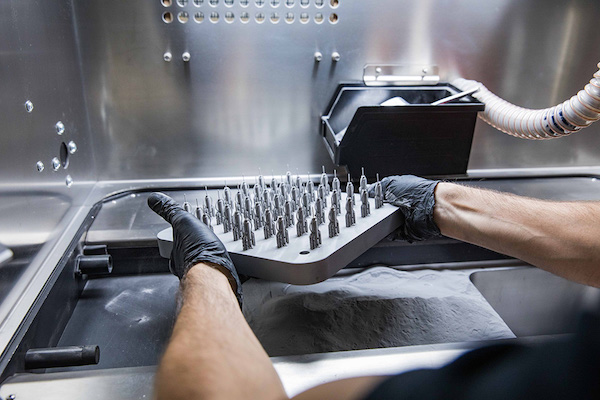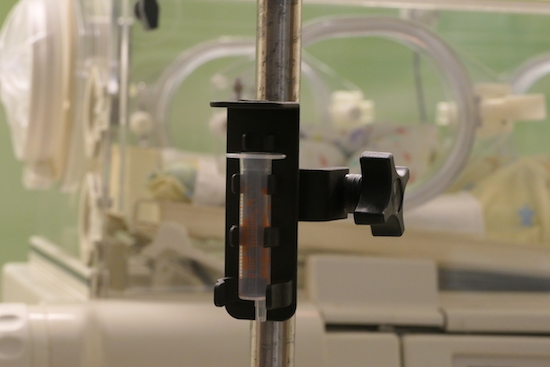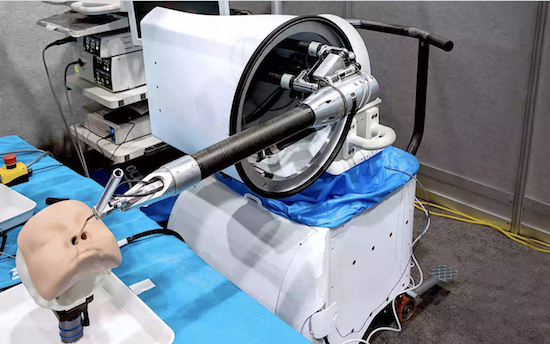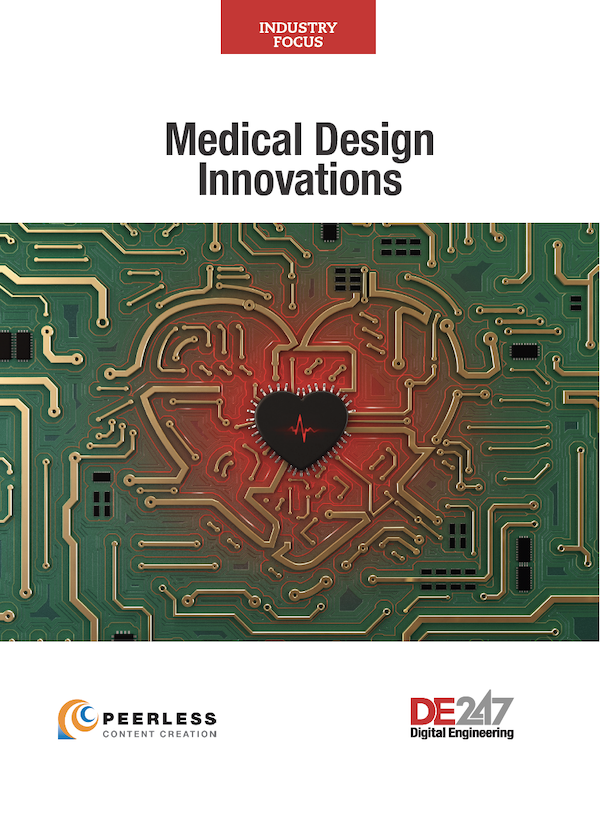
Metals and alloys can be suitable for medical applications, including those produced by Protolabs’ 3D printing process direct metal laser sintering (DMLS). Image courtesy of Protolabs.
Latest News
April 30, 2020
There’s no shortage of designers looking to make a positive impact on people’s lives. From neonatal feeding tubes to the end-of-arm tooling used on surgical robots, it’s clear that medical design innovation is alive and well. Getting these products through the approval process and into the medical community’s hands, however, is another story. Doing so requires a firm grasp of FDA procedures, a long-term business strategy, and a working knowledge of medical-grade materials and manufacturing techniques.
Cool Ideas and Long-Term Strategies
One company with all of these attributes is MedStar Health in Columbia, MD. A recent recipient of Protolabs’ Cool Idea Award Healthcare Grant, the medical provider’s team designed a gravity-feed syringe holder to simplify the feeding of newborns assigned to neonatal intensive care units (NICUs) and to potentially support patient care in other settings. According to a related press release, inventor Tiffany Morris, an RN who works in the NICU at MedStar Franklin Square Medical Center, used the Protolabs grant to improve the device’s design, “smoothing the corners, adding sturdier syringe clips, and incorporating gaskets to keep infants safe while protecting the incubator.”
Chris Stevens, senior R&D engineer and medical specialist at Minneapolis-based Protolabs, said this is but one of the many examples of how digital manufacturers can support product designers as they move their wares from concept to reality. Because Protolabs and other quick-turn manufacturers provide a range of services—machining, plastic injection molding, sheet metal fabrication, and 3D printing among them—as well as a host of metals and polymers, designers have access to partners that can support them through product release and beyond.
They also provide design expertise. “Because we work with such a wide variety of customers and review thousands of designs annually, we’re able to look at a customer’s project and offer suggestions,” he said. “In MedStar’s case, the tweaks were fairly simple, but we might also make recommendations on whether to machine or 3D print a part, provide design for manufacturability feedback, or even help them to develop a long-term manufacturing approach.”
This last part is essential, Stevens added. Without a plan—even one that is sure to change over time—product designers often end up moving quickly but in the wrong direction. The result is lost time, wasted money, and missed opportunities, but having a knowledgeable partner can help you avoid many of those pitfalls. “Our goal is to get customers to FDA approval as quickly as possible, but do so in an orderly, cost-effective manner,” he said. “In the medical industry, where quality, repeatability and reliability are critical, it’s essential to have a manufacturing partner that can deliver that. At Protolabs, we are proud to offer that through our in-house manufacturing scale and expertise.”

This device simplifies the feeding of newborns assigned to neonatal intensive care units (NICUs) and to potentially support patient care in other settings. It was developed as part of Protolabs’ Cool Idea Award Healthcare Grant. Image courtesy of MedStar Health.
Making Choices
As for specific design advice, Stevens has plenty, although he’s quick to point out such information is entirely dependent on the application. Consider material selection. Yes, properties such as biocompatibility and sterilization must be addressed, but it's also necessary for designers to recognize that the raw material they select early on may well chart the course for long-term manufacturing. For example, the polymer grade used to make a 3D printed prototype might not be available for injection molding, potentially forcing the designer to resubmit an already approved design once this and other all-too-frequent faux pas are discovered.
Despite these warnings, Stevens suggested that there’s no reason to settle for the traditional three-year development cycle common in the medical industry. “The stakes are high with medical products, but I don’t see that this long, drawn-out process is always necessary,” he said. “Because designers today can quickly produce multiple iterations of a product and then immediately scale up after approval, the question should be, “How can we get to market in a few months, rather than several years?”
The answer might be sitting in your pocket. That’s according to Tommy Lynch, senior applications engineer at Xometry Inc., Gaithersburg, MD, who said he's seen a rise in product designs over the years that leverage mobile devices, in some cases eliminating the need for onboard electronics that might otherwise take years to develop and source. “It's not only faster to design and more compact, but more convenient for the end-user as well,” he said. “Everybody has a cell phone these days, and using one as a computing platform often means not having to go through a major medical device manufacturer to get supporting equipment. Now designers can have an app created, and design attachments that are plug and play.”
Technical sales engineer Kyra Stawson agreed, noting that Xometry’s diverse supply chain is helpful in this respect as well. “Because we operate off a network of partners, we're not relying on one facility in the middle of South Carolina, for example, to manufacture everything,” she said. “We're very agile and can move components around as needed based on a supplier's capacity and capabilities, which also allows us to ramp up as the project moves into production. This means Xometry can take the project from the original design inception to a 3D printed prototype, the pre-production Beta test, and onto a finished product in full production.”
 From neonatal feeding tubes to the end-of-arm tooling used on surgical robots, medical design innovation is alive and well. Image courtesy of Xometry.
From neonatal feeding tubes to the end-of-arm tooling used on surgical robots, medical design innovation is alive and well. Image courtesy of Xometry.Setting Goals
Stawson and Lynch reiterated the need for a plan at the start of any medical project, even while recognizing that said plan may change midstream. And as Protolabs’ Stevens already noted, they said material selection is a critical factor, especially where 3D printing will be used. “There's only a handful of suppliers that will provide a certificate stating that a powder or rod is biocompatible,” Lynch said. “Many will supply raw material certificates stating biocompatibility, but that designation changes as soon as it is run through a printer, where multiple material lots may be combined or recycled to keep costs low for commercial applications.”
This is an important consideration for anyone aiming to take their 3D-printed prototype into production, although Stawson was quick to point out that this constraint does not hold true for injection molding. “These requirements are easy to achieve with the right equipment,” she said.
There's more. Xometry and Protolabs alike pointed out their commitment to material traceability, without which any medical device supplier will soon find itself up the proverbial creek without a legal paddle. In addition to raw material, certification also extends to the production floor, however, where cleanroom standards are often required, making it doubly important for designers to select a manufacturing provider with the expertise, capabilities, and scalability to see them through the long haul.
“I've seen many cases where a designer comes up with a really clever idea, prototypes it, and maybe even gets their product approved for some level medical use, only to discover that they've painted themselves into a corner,” Lynch said. “The prototyping material or technology may have worked well for concept or testing purposes, but does not achieve economies of scale needed for production. We want to help customers avoid this situation whenever possible, and the best way to do that is by talking to us about their project's application and production goals.”
Stawson agreed, adding, “If the goal is to take a prototype into production, these conversations need to take place as early as possible, preferably before prototypes are made, to accommodate for injection molding design limitations and guidelines. Ultimately, we want to make anyone’s dream or goal come to fruition; let’s work together on making this achievable from the start.”
More Protolabs Coverage
Subscribe to our FREE magazine, FREE email newsletters or both!
Latest News
About the Author
Kip Hanson writes about all things manufacturing. You can reach him at .(JavaScript must be enabled to view this email address).
Follow DE




